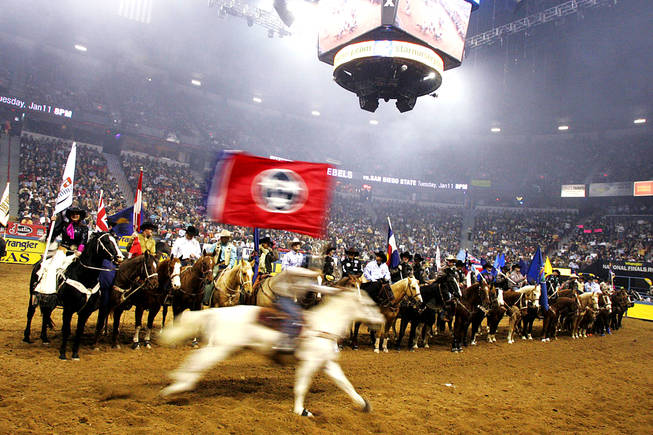
Sam Morris / Las Vegas Sun
Contestants are introduced at the start of the first go round of the National Finals Rodeo Thursday, December 2, 2010 at the Thomas & Mack.
Thursday, Dec. 1, 2011 | 2 a.m.
Sun NFR coverage
The National Finals Rodeo — now formally the Wrangler National Finals Rodeo — has been held in Las Vegas since Ronald Reagan was in the White House.
It returns today for another 10-day run at the Thomas & Mack Center. For casual fans, or even those who wouldn’t know a Brahman from a llama, here’s some basic info to get you out of the chute.
What’s the schedule?
Events run from 6:45 to 9 p.m. every day except for Sunday, when the hours are 12:45 to 3 p.m.
Can I still get tickets?
The rodeo is sold out — but there are options for those who still want to go. One is to visit NFRexperience.com and access the National Finals Rodeo ticket exchange site, where ticket holders sell unwanted tickets. Another exchange is available at the Cowboy Christmas Gift Show, which opens at 10 a.m. daily at the Las Vegas Convention Center. Also available is the NFR’s Mad Dash 30 ticket option, which gives spectators access to the concourses and a 30-minute window to find an empty seat in the balcony. If they come up empty, they can either watch the event from the concourse or get a refund for the ticket, minus processing fees. For all ticket inquiries, fans can call the Thomas & Mack Center ticket office at 866-388-FANS.
What do tickets cost?
This week, prices on the ticket exchange site started at $47.70.
What's the seating capacity at the Thomas & Mack Center?
The arena seats 17,500 when configured for the rodeo.
And if I’m a couch potato?
Great American Country TV will telecast it live all 10 nights. GACTV is available on Dish Satellite TV channel 167, DirecTV channel 326 and Cox cable channel 374 in Las Vegas.
In addition, more than 40 Nevada hotels and resort properties will be showing satellite feeds of every NFR performance. For a list of the sites, visit
www.nfrexperience.com/home/satellite_feed.
What’s involved in setting up the Thomas & Mack Center for a rodeo?
Here are some of the ingredients: 2,500 tons of dirt (enough to fill the main arena and a warm-up arena), 2,000 bales of straw and other shavings, 110 tons of hay, 30 tons of feed grain and seven tractor-trailer loads of panels, gates and other penning material.
What makes those bulls and bucking broncs so angry?
Welcome to one of the biggest sources of heartburn in rodeo. Supporters have long faced claims that animals are shocked with cattle prods, beaten or otherwise provoked into performing in the ring. One very common contention is that the animals’ testicles are bound tightly in leather straps.
It’s all untrue, say those who help put on the event.
“That’s a myth propagated by PETA and whatnot,” said Dr. Garth Lamb, a large-animal veterinarian who has staffed the NFR every year it’s been here.
Lamb, who practices at the Desert Pines Equine Medical & Surgical Center in Las Vegas, says the animals are fitted with a strap or cotton rope that contacts their flanks. But the equipment is an irritant that causes no injury, he says — “No scrapes, no cuts, anything.”
Is there a voice of the rodeo, like there’s a voice of the Dodgers?
Yep. His name is Boyd Polhamus, and he’s been the announcer at the NFR since 1990. Polhamus goes on the road something like 300 nights a year to call action at rodeos, and it’s safe to say he’s an encyclopedia of knowledge about the sport. Not only does he work behind the microphone, he raises livestock. His secret to avoiding laryngitis? “If you can stand it, gargle apple cider vinegar,” he said. “You won’t sound good, but at least you’ll be able to make a sound.”
How many participants are involved?
The field features 120 competitors, with another 1,000 support workers, concessions operators, media representatives and other people staffing the event.
And animals?
Between bulls and broncs, roping steers and calves, barrel racing horses and stock used by handlers, about 750 animals will be hoofing around the Thomas & Mack. The bucking animals are selected by competitors based on how the livestock have performed throughout the season.
What are the rules, besides the one about riding for 8 seconds?
Polhamus says casual fans can avoid a lot of confusion by understanding two basic rules. One, which applies to bronc riding, is that the rider’s heels must be above the horse’s shoulders when it makes its first jump — or the cowboy will be disqualified. The other rule, which applies to roping events, requires riders to give a head start to animals they’re chasing down. A violation brings a 10-second penalty. In both cases, Polhamus says, fans can see what otherwise looks like a spectacular performance go for naught, not unlike watching a kick returner in football run for a touchdown, only to then see the play nullified by a penalty. The difference is that in rodeo, the flag isn’t thrown on the field, and fans may not understand why the penalty happened.
What are the animals worth?
A barrel-racing horse with good bloodlines and training can go for as much as $300,000, Polhamus said. Those animals are at the top of the pyramid, value-wise, because of their athleticism and ability to respond to input from riders.

Join the Discussion:
Check this out for a full explanation of our conversion to the LiveFyre commenting system and instructions on how to sign up for an account.
Full comments policy